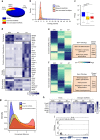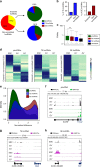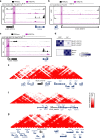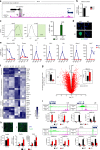A transcribed enhancer dictates mesendoderm specification in pluripotency
- PMID: 29180618
- PMCID: PMC5703900
- DOI: 10.1038/s41467-017-01804-w
A transcribed enhancer dictates mesendoderm specification in pluripotency
Abstract
Enhancers and long noncoding RNAs (lncRNAs) are key determinants of lineage specification during development. Here, we evaluate remodeling of the enhancer landscape and modulation of the lncRNA transcriptome during mesendoderm specification. We sort mesendodermal progenitors from differentiating embryonic stem cells (ESCs) according to Eomes expression, and find that enhancer usage is coordinated with mesendoderm-specific expression of key lineage-determining transcription factors. Many of these enhancers are associated with the expression of lncRNAs. Examination of ESC-specific enhancers interacting in three-dimensional space with mesendoderm-specifying transcription factor loci identifies MesEndoderm Transcriptional Enhancer Organizing Region (Meteor). Genetic and epigenetic manipulation of the Meteor enhancer reveal its indispensable role during mesendoderm specification and subsequent cardiogenic differentiation via transcription-independent and -dependent mechanisms. Interestingly, Meteor-deleted ESCs are epigenetically redirected towards neuroectodermal lineages. Loci, topologically associating a transcribed enhancer and its cognate protein coding gene, appear to represent therefore a class of genomic elements controlling developmental competence in pluripotency.
Conflict of interest statement
S.O. and T.P. filed a patent about therapeutic use of cardiac-enriched lncRNAs. Patent title: “Diagnostic, prognostic and therapeutic uses of long noncoding RNAs for heart disease and regenerative medicine”; International application number: PCT/EP2014/078868; Applicant: University of Lausanne, Switzerland. The remaining authors declare no competing financial interests.
Figures







References
Publication types
MeSH terms
Substances
LinkOut - more resources
Full Text Sources
Other Literature Sources
Molecular Biology Databases
Research Materials

